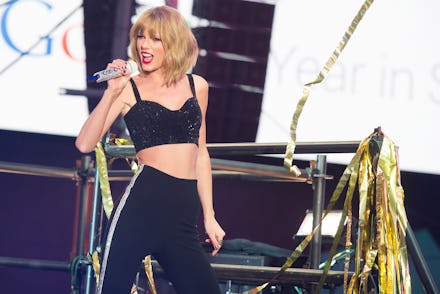What Our Fascination With Taylor Swift's Belly Button Really Says About Us

A generally overlooked appendage took the Internet by storm yesterday, when Taylor Swift's belly button made what many are calling it's first ever public appearance in an Instagram photo. With one click, the pop star, who is on vacation with the HAIM sisters in Hawaii, shut down years of speculation about the nature of her "mysterious" belly button, which she said she has deliberately kept hidden lest she "fully [commit] to the midriff thing."
"Taylor Swift Finally Shows Belly Button, Proves She's Human," Jezebel quipped. "She really does have one!" Caitlin Scott wrote over at Cosmo. The media reaction would be hilarious if it weren't so disconcerting. Yes, Taylor Swift is human, she has a navel — she's had one longer than Barbie, in fact. As much as the media contends that Swift is guilty of "diaristic 'navel-gazing,'" the fact that we were so enchanted, perplexed and even stymied by the "mysterious" absence of one anatomical detail says a lot about our intention to keep female celebrities locked into sexist stereotypes.
Culturally, the navel has occupied an odd in-between space for a long time. This is evident in how the navel has been regarded as taboo in American cultural history alone. The Hays Code of the 1930s encouraged networks to uphold a certain propriety when it came to anatomy; NBC at first explicitly prohibited belly buttons on I Dream of Jeannie in the 1960s, but eventually approved them in the fifth season to quell the media's fascination with star Barbara Eden's apparently nonexistent navel. Both innocent and somehow sexual, the combination as been salaciously provocative for decades.
From the late 1990s, it seems that the media has demanded its female celebrities to expose their navels in order to fulfill the male fantasy of the willing virgin — that is, both innocent and sexual. Britney Spears was arguably one of the first pop stars to successfully capitalize upon this early in her career, when she sang about being "not that innocent" while donning one of her iconic navel-baring outfits.
Taylor Swift, however, has so far denied the media its sexist fantasy, refusing to play into the female celebrity stereotype. The media retaliated against her lack of capitulation, either criticizing her as a stuck-up, plastic Barbie or sarcastically ruminating, as Carl Wilson did over at Slate, on why such a "navel gazer" doesn't expose her navel.
Here's the point: The media doesn't like losing control of the narrative, even when that narrative concerns someone else's body. This is clear from the way some journalists seem to judge Swift for refusing to fit into its mold of what a sexy-yet-innocent young female pop star should look like and how she should act. She controlled her subjectivity, not the media, and that pissed them off.
Swift's big reveal is revealing not because we finally know that she has an innie — it's a navel, get over it. The Instagram photo and the global reaction it caused exposes how much we demand to control women's bodies.